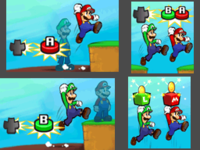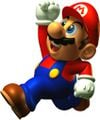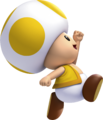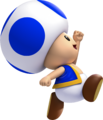Jump: Difference between revisions
No edit summary |
|||
| Line 17: | Line 17: | ||
In ''[[Mario Bros. (game)|Mario Bros.]]'', jumping was the primary attack of Mario and Luigi and the only way to defeat [[enemies]]. By jumping at the platforms on which the enemies were standing on from below, the player could turn the enemies around. The enemies would then have to be finished off with a kick. Unlike future games, stomping on enemies is still deadly in ''Mario Bros.'' Because of this, the [[Shellcreeper]]s have been changed to [[Spiny|Spinies]] in all remakes of the game to remind players not to stomp on them. | In ''[[Mario Bros. (game)|Mario Bros.]]'', jumping was the primary attack of Mario and Luigi and the only way to defeat [[enemies]]. By jumping at the platforms on which the enemies were standing on from below, the player could turn the enemies around. The enemies would then have to be finished off with a kick. Unlike future games, stomping on enemies is still deadly in ''Mario Bros.'' Because of this, the [[Shellcreeper]]s have been changed to [[Spiny|Spinies]] in all remakes of the game to remind players not to stomp on them. | ||
===[[Super Mario (series)|''Super Mario'' series]]=== | ===[[Super Mario (series)|''Super Mario'' series]]=== [[File:Smlmario.png|thumb|A sprite of Small Mario jumping]] | ||
Since ''[[Super Mario Bros.]]'', jumping has been a much more integral part of the [[Mario (series)|''Mario'' series]], and is no longer used solely to jump over gaps and enemies. In later games of the series, Mario and other playable characters use a greater variety of jump moves which can be used to reach certain areas or get bonus [[items]] from special [[block]]s. These include the [[Spin Jump]] from ''[[Super Mario World]]'', the [[Ground Pound]] first seen in ''[[Super Mario World 2: Yoshi's Island]]'', and even the [[Double Jump]], [[Triple Jump]], and [[Wall Jump]] introduced in ''[[Super Mario 64]]''. | Since ''[[Super Mario Bros.]]'', jumping has been a much more integral part of the [[Mario (series)|''Mario'' series]], and is no longer used solely to jump over gaps and enemies. In later games of the series, Mario and other playable characters use a greater variety of jump moves which can be used to reach certain areas or get bonus [[items]] from special [[block]]s. These include the [[Spin Jump]] from ''[[Super Mario World]]'', the [[Ground Pound]] first seen in ''[[Super Mario World 2: Yoshi's Island]]'', and even the [[Double Jump]], [[Triple Jump]], and [[Wall Jump]] introduced in ''[[Super Mario 64]]''. | ||
Revision as of 12:46, April 7, 2015
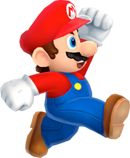
- “As you know, the primary action for mobile creatures is the jump, if you follow.”
- —Stuffwell, Mario & Luigi: Partners in Time
Jumping is the trademark move of Mario. While it was originally only used to evade obstacles in the original Donkey Kong game, it has been Mario's primary method of attacking since Super Mario Bros. Depending on the type of game, Mario and other characters jump for a variety of different purposes.
History
Donkey Kong series
Donkey Kong
In the original arcade version of Donkey Kong, Mario had to jump over the barrels that Donkey Kong threw at him. He could only jump high enough to leap right over the barrel, in contrast to the impossibly high jumps in the Super Mario Bros. series. If Mario landed on a barrel in the game, he would die. In the early concept of Donkey Kong, Mario originally wasn't able to jump. It was implemented when Shigeru Miyamoto and his team thought "If you had a barrel rolling towards you, what would you do?".[1]
Donkey Kong (Game Boy)
In Donkey Kong on the Game Boy, Mario has a greater variety of moves related to jumping. If the player jumped, then pressed down on the d-pad, Mario would make a handstand. From the handstand position, Mario could perform high jumps and wide jumps depending on the situation. Mario could also backflip by walking and then immediately pressing the opposite direction and the jump button, resulting in him going high into the air backwards. Unlike all other 2D Mario titles, Donkey Kong would also punish the player for falling too far, resulting in Mario losing a life. This jump system has also been used in Mario vs. Donkey Kong.
Mario Bros.
In Mario Bros., jumping was the primary attack of Mario and Luigi and the only way to defeat enemies. By jumping at the platforms on which the enemies were standing on from below, the player could turn the enemies around. The enemies would then have to be finished off with a kick. Unlike future games, stomping on enemies is still deadly in Mario Bros. Because of this, the Shellcreepers have been changed to Spinies in all remakes of the game to remind players not to stomp on them.
===Super Mario series===
Since Super Mario Bros., jumping has been a much more integral part of the Mario series, and is no longer used solely to jump over gaps and enemies. In later games of the series, Mario and other playable characters use a greater variety of jump moves which can be used to reach certain areas or get bonus items from special blocks. These include the Spin Jump from Super Mario World, the Ground Pound first seen in Super Mario World 2: Yoshi's Island, and even the Double Jump, Triple Jump, and Wall Jump introduced in Super Mario 64.
Super Mario Bros.
Super Mario Bros. features various types of Brick Blocks which Mario can find coins in, as well as ? Blocks that contain Super Mushrooms and Fire Flowers. To break these blocks, the player must jump while under them. Mario can also defeat enemies like Goombas and Hammer Bros. by stomping on them. Koopa Troopas are not defeated by the stomp, but hide in their Green Shells, which can then be kicked by the player. Hammer Bros., Cheep Cheeps, Bowser Impostors, and Bowser himself all jump in the game as well.
Super Mario Bros. 2
In Super Mario Bros. 2, jumps served a different purpose than in all other games, due to the game using the only slightly altered Yume Kōjō: Doki Doki Panic as its engine. The characters in the game could not defeat any enemies by stomping on them. Instead, they could stand on them and pick them up by using the B button. Players could even land on Birdo's eggs and throw them at Birdo. Enemies and items could be picked up and thrown to knock out other enemies. This system has been carried over to Donkey Kong on the Game Boy.
Super Mario Sunshine
In Super Mario Sunshine, Mario's jump can defeat most enemies. When using F.L.U.D.D.'s Hover Nozzle, Mario can float higher and longer. In addition, if Mario loses health, his jumps become weaker. Also, if Mario jumps over a gap or a void, his jumps are different.
Mario Kart series
In Super Mario Kart, players could hop with the press of a button. The Feather allowed them to do a high jump. Jumps can be used to cross gaps and to take shortcuts. In later games of the Mario Kart series, jumping is usually only possible when using ramps. In Mario Kart Wii, Mario Kart 7 and Mario Kart 8, it was possible to do tricks after jumping off, giving players a small boost.
Super Mario RPG: Legend of the Seven Stars
In Super Mario RPG: Legend of the Seven Stars, the Jump was a special move that requires 3 Flower Points. It does additional damage as a Timed Hit, and its power increases with the Jump Shoes. Mario can use this move from the beginning of the game on. Mario's jump was also used by many characters in the game to verify his identity. Everyone also seems to think of it as his most defining characteristic.
Paper Mario series
Jumping is present in every installment of the Paper Mario series.
In Paper Mario and Paper Mario: The Thousand-Year Door, jumping is Mario's primary attack he can use from the beginning of the game. It can be used to defeat any kind of generic enemy like the Goombas, but some enemies like the Spiked Goombas would prevent jump attacks with spikes, and the player would have to use the Hammer attacks instead. Jumping is also used on the overworld for platforming elements. In both games, Mario can increase his jump power and abilities with the Super Boots and the Ultra Boots.
In Super Paper Mario, all four characters have the ability to jump on foes as their primary means of attack.
Paper Mario: Sticker Star features multiple Jump stickers that can be used in battle, each with various strengths. There are seven different types of Jumps, each with their own variations: the Jump, Iron Jump, Hopslipper, Infinijump, Line Jump, and Clone Jump.
Mario & Luigi series
Mario & Luigi: Superstar Saga
Mario & Luigi: Superstar Saga used the same concept for jumps as the Paper Mario series. On the overworld, Mario and Luigi could also perform the High Jump and the Spin Jump to reach higher areas. Many Bros. Attacks would also use jump moves.
A Glurp is extremmely resistant to jump attacks.
Mario & Luigi: Partners in Time
In Mario & Luigi: Partners in Time, the jump command was identical to how it was in Mario & Luigi: Superstar Saga, however, the piggyback jumps with Baby Mario and Baby Luigi increased the number of jump commands.
Mario & Luigi: Bowser's Inside Story
In Mario & Luigi: Bowser's Inside Story, the jump works similar to how it did in Mario & Luigi: Partners in Time, with Mario and Luigi performing multiple jumps with a well-timed Action Command.
Mario & Luigi: Dream Team
In Mario & Luigi: Dream Team, the Jump attacks for Mario and Luigi are identical in game-play to the ones in Mario & Luigi: Bowser's Inside Story, although in the Dream World, successful Jump attacks cause several Luiginoids to fall on to surrounding enemies after Mario attacks. In the overworld, this game uses the Jump field action as usual for the series, and features the Spin Jump and the Ball Hop, a move very similar to the High Jump from Mario and Luigi: Superstar Saga. The Template:Conjecturaltext also uses the Jump action while in the Luiginoid Stack formation.
The Jump attack is also used during the Giant Battles by Giant Luigi, the result of Dreamy Luigi and many Luiginoids' combination. This involves Luigi first bobbing down as if he was about to spring into the air, where the player must wait until Luigi flashes to slide up quickly on the Touch Screen. Perfect timing will allow Luigi to land firmly on the target and perform a second jump on them if the player succeeds in repeating the command. Perfect timing with both jumps will yield in an Excellent! rating, perfect timing on only one will yield in a Great! rating, sliding up at the wrong time will result in a Good! rating and not sliding up at all will result in an OK! rating.
Descriptions
Mario - Press the A button as you land to jump again. Time two jumps for an Excellent!
Luigi - Press the B button as you land to jump again. Time two jumps for an Excellent!
Giant Luigi - Charge up for extra oomph!
Luigi's Mansion: Dark Moon
In Luigi's Mansion: Dark Moon, Luigi can jump while he is sucking up a ghost to avoid attacks from other ghosts. This is executed by pressing the button while using the Poltergust 5000 to suck up the ghost.
Super Smash Bros. series
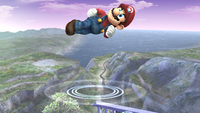
In the Super Smash Bros. series, a jump can be performed by all characters. Each character has a different jump height and different window of time where they crouch before they jump. Template:Seealso
Super Mario Galaxy
In Super Mario Galaxy, Mario can jump by pressing the a button on the Wiimote, but while he is jumping he can use a spin just in case he is near a cliff. He can still hit enemies who are not spiky, however, this choice is also ineffective against cold enemies such as Brr Bits since the cold protects them and Mario will get harmed instead. Some of Mario's foes, such as Goombas, can jump to defend themselves from getting stomped on and to damage Mario.
List of jump types
- Back Flip
- Co-Star Super Jump
- Double Jump
- Floaty Jump
- Flutter Jump
- Fly
- Footstool Jump
- High Jump
- Hop
- Long Jump
- Piggyback Jump
- Power Squat Jump
- Scuttle
- Somersault
- Spin Jump
- Spring Jump
- Spring Jump (Sonic the Hedgehog)
- Stomp
- Super Jump
- Super Jump Punch
- Tornado Jump
- Triple Jump
- Ultra Jump
- Wall Jump
Gallery
- SMB-Mario Jumping.png
- 320099-mario1.jpg
- 320102-mario1alt.jpg
Super Mario Bros.: The Lost Levels - Marioveggie.jpg
- Mariosmb2.jpg
Super Mario Bros. 2
- 20120408184433!Ssbmmario.jpg
- Sms mario jump.jpg
- Mario PM2.png
- Mario luigi jump.jpg
- Tykemario.jpg
- NsmbMario.jpg
- NsmbLuigi.png
New Super Mario Bros. Wii
- YellowToad2.png
New Super Mario Bros. Wii
- BlueToad.png
New Super Mario Bros. Wii
- Mario - New Super Mario Bros U.png
- Luigi - New Super Mario Bros U.png
New Super Mario Bros. U
- NSMBU FourCharacters.png
New Super Mario Bros. U
- WiiU NewMarioU 2 char01 E3.png
New Super Mario Bros. U
Names in other languages
References
- Jumps
- Moves
- Special Moves
- Super Mario RPG Moves
- Super Smash Bros. Special Moves
- Donkey Kong Special Moves
- Wario Special Moves
- Donkey Kong (game)
- Luigi's Mansion: Dark Moon
- Mario & Luigi: Bowser's Inside Story
- Mario & Luigi: Dream Team
- Mario & Luigi: Partners in Time
- Mario & Luigi: Superstar Saga
- Mario Bros.
- New Super Luigi U
- New Super Mario Bros. 2
- New Super Mario Bros. U
- New Super Mario Bros. Wii
- New Super Mario Bros.
- Nintendo Land
- Paper Mario: Sticker Star
- Paper Mario: The Thousand-Year Door
- Paper Mario
- Super Mario 3D Land
- Super Mario 3D World
- Super Mario 64
- Super Mario Bros. 2
- Super Mario Bros.
- Super Mario Galaxy 2
- Super Mario Galaxy
- Super Mario Kart
- Super Mario RPG: Legend of the Seven Stars
- Super Mario Sunshine
- Super Mario World 2: Yoshi's Island
- Super Paper Mario
- Super Princess Peach
- Super Smash Bros. Brawl
- Super Smash Bros. Melee
- Super Smash Bros. Series
- Super Smash Bros.
- Wario World
- Yoshi Touch & Go
- Yoshi's Island DS
- Yoshi's Island: Super Mario Advance 3
- Yoshi's Story
